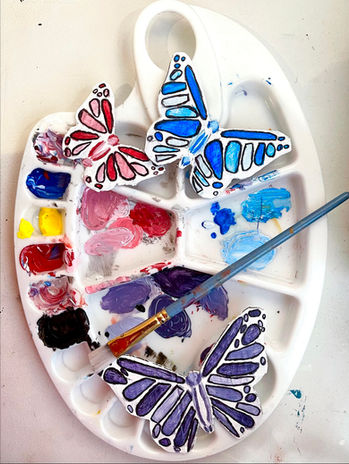Skilitis
Curatorial Rationale
Word Count: 704
My exhibition’s intention is to portray the process of entering adulthood and feeling astray by leaving behind your childhood innocence. I incorporated movement to represent the shifting phases of this process, color to symbolize childhood innocence and happiness, and contrast to display the changes of younger versus older self. This collection allowed me to comprehend the depth there is to growing up and becoming self-assured. The goal of my exhibition is to bring to light the highs and lows of when the simplicity of one’s childhood becomes a distant memory.
In a lot of my pieces, I used eyes as a symbol of a gateway into the soul. More specifically, they represented the part of you that wanted to invite back your carefree child persona. In Reaching In, the hand is reaching into an eye and grabbing onto the iris to represent trying to gain control of your perception. The hand is attempting to reclaim the simplicity and clear direction you had as a child. Similarly, in Visionary Dream, the two eyes peeking through the balloons highlight your subconscious fighting against your negativity to try and provide you direction. This fight within oneself is shown with the prominent red tears pooling out of the eyes. Additionally, the third piece in the series Deconstructed Meditation has a similar intention with the eyes in that they represent a spiritual awakening that is opposing a pessimistic mindset. Lastly, in Splitting, the two eyes are contrasting in color, showing the idea of the inner fight mentioned above. All in all, the eyes in my collection convey the idea of an opening in your mind trying to level you back to your roots.
Color and contrast were my strongest suits in this exhibition. Incorporating bright colors with black backgrounds or figures helped illuminate how vastly different growing up feels in comparison to being a naive child. Visionary Dream’s vibrant reds and pinks in the background and the bright blues and greens in the hills and balloons help animate “childhood innocence. The black hole that the arm is coming from provides contrast and a focal point to the piece. The black against vibrance aids in conceptualizing how coming out of a dark mental space resurfaces the exuberance you experienced as a child. In Splitting, color also takes an important role in depicting the freedom and vivacity from your younger years trying to remain in your persona as you grow older. Then, the contrasting muted skin tones melting into these colors demonstrate our obstructive headspace pushing down this innocent outlook. Another instance in which I feel color and contrast were strongly presented is in the series Detachment in the Abyss. The lively colored butterflies get lost in the black background in the same way our positivity tends to get lost in the abyss of despair.
The presentation in my work is set up in an order that is most appealing to viewers. There are two series in my exhibition. My digital photomontage, Deconstructed Meditation, is placed at the top because it has the brightest colors, and having the pieces of the series next to each other looked more organized. I had the same intention in terms of organization with my other series, Detachment in the Abyss. The pieces in this series are more on the darker side in comparison with my other works. Thus, placing this series in the bottom-most row felt right for visually appealing purposes. With my brightest pieces in the top row and my darker pieces in the bottom row, I was able to further the visual appeal with the second row. I placed another brightly-colored piece, Visionary Dream, in the center of the second row with two rather neutral-colored works, Reaching In and Splitting, on each side. This middle row thus balances out the exhibition by including colors from the top and bottom row. Not only that, but having two series start and end the exhibition adds an element of coherence to the viewing. My collection begins with a messy way of figuring out how to grow up “correctly” with the fear of forgetting what your childhood brought and taught to you. It then finishes with a simpler display of this process, showing growth and understanding.
